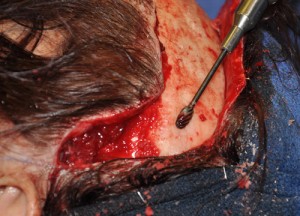A head that is too wide is marked by excessive convexity in the posterior temporal region above the ears. Often the width of the skin (even without hair) may stick out as much as the projection of the ear…and in some cases even more than that of the ear.
There is no question that the width of the temporal and parietal bone makes a contribution to head width but often less so than one would think. The thickness of the posterior limb of the temporalis muscle can be very thick, often as much as 7mm to 9mm in some individuals. The muscle does taper considerably as it reaches to the parietal region but the width of the head is often judged in a more anterior temporal position.

Head narrowing surgery can be moderately successful using a combined muscle and bone reduction technique. It does require at least a vertical incision above or behind the ear or can be done as part of a full coronal incision based on other concomitant craniofacial or skull reshaping procedures being done.
Dr. Barry Eppley
Indianapolis, Indiana


